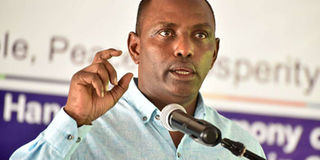Austerity plans flop as Sh3.5bn blown on travel

Acting National Treasury Cabinet Secretary Ukur Yatani commissions a project at the National Industrial Training Authority in Mombasa on November 29, 2019. The ministry has seen very little resources left for development. PHOTO | FILE | NATION MEDIA GROUP
What you need to know:
- The Treasury started the year with an opening balance of Sh98.9 billion while non-tax income added up to Sh12 billion.
- The infrastructure department was the top spending government agency on development. It spent Sh39.4 billion.
Austerity measures announced by the National Treasury last year appear to have done little to stop lavish and unnecessary expenditure at both levels of government.
This has seen very little resources left for development expenditure.
The latest report from the Office of the Controller of Budget (OCOB) shows that despite spending Sh571 billion in the first three months of this financial year, only Sh48 billion went to development expenditure.
This means that for every Sh100 spent between July and September 2019, only Sh10 went into development expenditure.
It translates to about 11 per cent and is a far cry from the recommended 30 per cent target.
Austerity measures were supposed to free up resources to be channelled into more development projects and spare taxpayers the burden of having to use 90 per cent of all its tax revenues to pay civil servants, buy office supplies, fuel cars and fund trips.
Some included a freeze on foreign travel and limiting training to government institutions.
DEBT CONUNDRUM
The report also brings home the reality of the debt burden the country is facing.
This is after Sh213 billion, which translates to about 40 per cent of the entire expenditure in the period, was used on servicing debt.
This comprised Sh81.1 billion for principal repayment and Sh132 billion towards interest payment.
In the current financial year, the government has allocated Sh696.6 billion towards payment of public debt.
The total expenditure on salaries was Sh98.8 billion, which is the biggest cost centre besides debt.
The bulk of this bill went to the Teachers Service Commission, which consumed Sh59.9 billion to keep teachers in school.
This represents 60.6 per cent of the total expenditure on personnel emolument.
Despite a freeze on foreign travel, public officers blew Sh3.5 billion on travelling, both at home and abroad, making it the third biggest recurrent expenditure item at the national government after salaries, and transfers to Semi-Autonomous Government Agencies (SAGAs) which consumed Sh91.3 billion.
BIG INCREASE
The national government Budget Implementation Review Report says domestic travel was the third highest expenditure category at Sh2.2 billion followed by foreign travel at Sh1.4 billion.
This was followed by Sh828.7 million on rental rates of non-residential buildings and Sh806.1 million on hospitality.
The Controller of Budget is required by the law to submit to both Houses of Parliament a report on the implementation of the budgets of both the national and county governments every four months.
The report prepared by Mr Stephen Masha, the acting Controller of Budget, covers the period July to September 2019.
In the three months, the government received Sh637.4 billion into the Exchequer Account. This represents 24.5 per cent of the annual target of Sh2.6 trillion.
It is a big jump from what the government received in a similar period in 2018, translating to an 18 per cent increase or Sh97.4 billion compared with Sh540 billion received in the previous year.
FUNDS DISTRIBUTION
Total tax income was Sh372 billion in the period, while domestic borrowing stood at Sh144 billion.
The Treasury started the year with an opening balance of Sh98.9 billion while non-tax income added up to Sh12 billion.
It is from these billions that it transferred Sh571.1 billion to ministries, departments and other agencies (MDAs), as well as the county governments.
This figure represents 22 per cent of the annual net estimates and translates to an increase of 33.3 per cent or Sh142.6 billion over a similar period in the 2018/19 financial year when Exchequer issues stood at Sh428.5 billion.
The report notes that Sh48 billion was channelled for development expenditure, Sh230.6 billion went to MDAs recurrent expenditure while Sh237.4 billion was sent to the Consolidated Fund Services (CFS), the kitty from where debt is repaid.
Another Sh55.1 billion was sent to county governments as shareable revenue from the national government.
RECURRENT EXPENDITURE
The infrastructure department was the top spending government agency on development expenditure after it spent Sh39.4 billion.
It was followed by the ministries of Energy (Sh11.6 billion), Transport (Sh6.4 billion), ICT (Sh4.7 billion) and Irrigation (Sh2.3 billion).
On the recurrent side, the TSC took the trophy after it spent Sh60.5 billion to pay salaries for tutors. It was followed by the State Department for Early Learning (Sh31.5 billion), Defence (Sh25.2 billion), Interior (Sh20.7 billion), and the Department for University Education (Sh13.8 billion).





